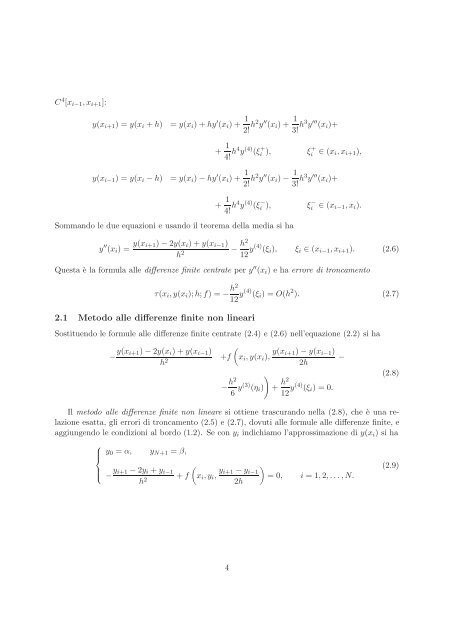problemi ai limiti per equazioni differenziali ordinarie - Sezione di ...
problemi ai limiti per equazioni differenziali ordinarie - Sezione di ...
problemi ai limiti per equazioni differenziali ordinarie - Sezione di ...
You also want an ePaper? Increase the reach of your titles
YUMPU automatically turns print PDFs into web optimized ePapers that Google loves.
C 4 [x i−1 ,x i+1 ]:y(x i+1 ) = y(x i + h) = y(x i ) + hy ′ (x i ) + 1 2! h2 y ′′ (x i ) + 1 3! h3 y ′′′ (x i )++ 1 4! h4 y (4) (ξ + i ), ξ+ i ∈ (x i ,x i+1 ),y(x i−1 ) = y(x i − h) = y(x i ) − hy ′ (x i ) + 1 2! h2 y ′′ (x i ) − 1 3! h3 y ′′′ (x i )++ 1 4! h4 y (4) (ξ − i ), ξ− i ∈ (x i−1 ,x i ).Sommando le due <strong>equazioni</strong> e usando il teorema della me<strong>di</strong>a si hay ′′ (x i ) = y(x i+1) − 2y(x i ) + y(x i−1 )h 2− h212 y(4) (ξ i ), ξ i ∈ (x i−1 ,x i+1 ). (2.6)Questa è la formula alle <strong>di</strong>fferenze finite centrate <strong>per</strong> y ′′ (x i ) e ha errore <strong>di</strong> troncamentoτ(x i ,y(x i );h;f) = − h212 y(4) (ξ i ) = O(h 2 ). (2.7)2.1 Metodo alle <strong>di</strong>fferenze finite non lineariSostituendo le formule alle <strong>di</strong>fferenze finite centrate (2.4) e (2.6) nell’equazione (2.2) si ha− y(x (i+1) − 2y(x i ) + y(x i−1 )h 2 +f x i ,y(x i ), y(x i+1) − y(x i−1 )−2h)− h26 y(3) (η i ) + h212 y(4) (ξ i ) = 0.Il metodo alle <strong>di</strong>fferenze finite non lineare si ottiene trascurando nella (2.8), che è una relazioneesatta, gli errori <strong>di</strong> troncamento (2.5) e (2.7), dovuti alle formule alle <strong>di</strong>fferenze finite, eaggiungendo le con<strong>di</strong>zioni al bordo (1.2). Se con y i in<strong>di</strong>chiamo l’approssimazione <strong>di</strong> y(x i ) si ha⎧⎪⎨⎪⎩y 0 = α, y N+1 = β,− y i+1 − 2y i + y i−1h 2(+ f x i ,y i , y )i+1 − y i−1= 0, i = 1,2,... ,N.2h(2.8)(2.9)4
















